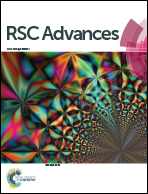Nanocomposites by the use of simultaneous twin polymerization: tin alloys in a carbon/silica matrix†
Abstract
Twin polymerization is a novel nonaqueous route to synthesize organic–inorganic hybrid materials composed of interpenetrating phase nanodomains. Here we present the Simultaneous Twin Polymerization (STP) of 2,2′-spirobi[4H-1,3,2-benzodioxasiline] (Si-spiro) in the presence of tin(II)-2,4-dimethoxyphenylmethanolate (1) mixed with a variety of metal additives, such as iron(III), nickel(II), copper(II) and cobalt(II) carboxylates. Nanocomposites composed of nanostructured tin alloys embedded in a carbon/silica matrix were obtained after treatment of the hybrid materials under reductive conditions using hydrogen. This approach allows the synthesis of a variety of tin alloys such as Sn2Co, Sn2Fe, Sn2Ni3, Sn3Ni4 and Sn5Cu6 which are embedded in a porous carbon/silica matrix. The as-prepared nanocomposites show BET surface areas up to 327 m2 g−1 and particles sizes of the tin alloys in the range of a few to hundreds of nm. High-angle annular dark field scanning transmission electron microscopy (HAADF STEM) reveals a homogeneous distribution of the nanoparticular tin alloys in the carbon/silica matrix, which makes the nanocomposites potential anode materials for lithium-ion batteries as was demonstrated for the Sn2Ni3-based material.


 Please wait while we load your content...
Please wait while we load your content...